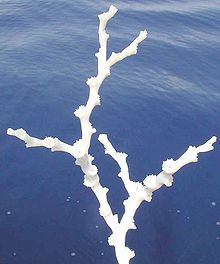Lophelia
| Lophelia pertusa | |
|---|---|
 |
|
| Scientific classification | |
| Kingdom: | Animalia |
| Phylum: | Cnidaria |
| Class: | Anthozoa |
| Order: | Scleractinia |
| Family: | Caryophylliidae |
| Genus: |
Lophelia Milne-Edwards & Haime, 1849 |
| Species: | L. pertusa |
| Binomial name | |
|
Lophelia pertusa (Linnaeus, 1758) |
|
 |
|
| Known range (NOAA) | |
| Synonyms | |
|
|
Lophelia pertusa, the only species in the genus Lophelia, is a cold-water coral which grows in the deep waters throughout the North Atlantic ocean, as well as parts of the Caribbean Sea and Alboran Sea.L. pertusa reefs are home to a diverse community, however the species is extremely slow growing and may be harmed by destructive fishing practices, or oil exploration and extraction.
Lophelia pertusa is a reef building, deep water coral, but it does not contain zooxanthellae, the symbiotic algae which lives inside most tropical reef building corals. Lophelia lives between 80 metres (260 ft) and over 3,000 metres (9,800 ft) depth, but most commonly at depths of 200–1,000 metres (660–3,280 ft), where there is no sunlight, and a temperature range from about 4–12 °C (39–54 °F).
As a coral, it represents a colonial organism, which consists of many individuals. New polyps live and build upon the calcium carbonate skeletal remains of previous generations. Living coral ranges in colour from white to orange-red. Unlike most tropical corals, the polyps are not interconnected by living tissue. Each polyp has up to 16 tentacles and is a translucent pink, yellow or white. Some colonies have larger polyps while others have small and delicate -looking ones. Radiocarbon dating indicates that some Lophelia reefs in the waters off North Carolina may be 40,000 years old, with individual living coral bushes as much as 1,000 years old.
The colony grows by the budding off of new polyps. Living polyps are present on the edges of dead coral and fragmentation of coral colonies provides one form of asexual reproduction. Each colony is either male or female and sexual reproduction occurs when these liberate sperm and oocytes into the sea. The larvae do not have a feeding stage, but sustain themselves on their yolks and drift with the plankton, possibly for several weeks. On settling on the seabed, they undergo metamorphosis and develop into polyps which potentially start new colonies.
...
Wikipedia
